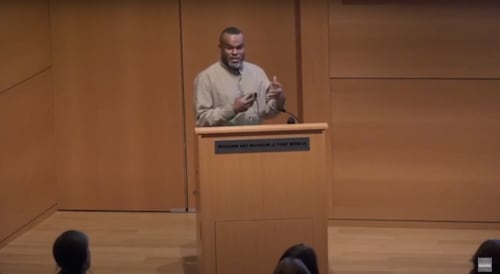River Bends to Gulf (Double Time) is a meditation on the city of New Orleans as a sonic territory, and speculates on the flow of the river, and what was shipped up and down it, as a direct influence on the musical culture of the area. I am exploring the idea that there are cities with crossroads of waterways and as we know crossroads has an important place within the cultures of the African Diaspora. –Jamal Cyrus
Artist Jamal Cyrus, in conjunction with FOCUS: Jamal Cyrus, presents the trajectory of his research-driven approach to artmaking that explores ignored, forgotten, and fragmented accounts of Black American culture. He focuses here on what he terms the “sonic territory,” which considers the influences that cultural interaction, labor, wildlife, landscape, and geology have on the musical culture of the Dallas/Fort Worth area. As a multidisciplinary artist, Cyrus explores gaps in Black American history, striving to better understand cultural and national heritage in the context of Black political movements, social justice issues, and the influence of the African diaspora. He explains, “I see my work as a form of self-education. Due to the illegality of teaching the enslaved to read and write, and the subsequent lack of access to education following Emancipation and well into the middle of the 20th century, the action of teaching oneself has a long history within Black culture.”
This talk was recorded at the Modern Art Museum of Fort Worth on March 29. 2023.
Jamal Cyrus received his BFA from the University of Houston, attended the Skowhegan School of Painting and Sculpture, and received an MFA from the University of Pennsylvania. He has won awards including the Louis Comfort Tiffany Foundation Award, Artadia Houston Award, Smithsonian Artist Research Fellowship, Joan Mitchell award, and Driskell Prize, awarded by the High Museum of Art, Atlanta. Cyrus was also a member of the artist collective Otabenga Jones and Associates, which, among other significant exhibitions, was included in the 2006 Whitney Biennial.

